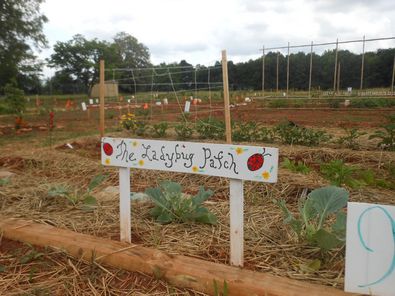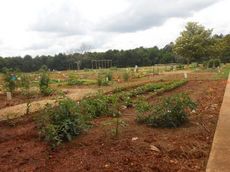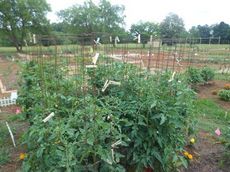BY BUDDY WATERS
MASTER GARDENER
The Community Garden is starting to look like a garden now. Plants have matured and are beginning to bloom and set fruit.
1. Watch your tomatoes and squash for signs of blossom end rot caused by a lack of calcium in the soil. You can add calcium with bone meal or gypsum. Both of these amendments are available in small (1-2 pound) packages at the home improvement stores and garden shops. The feed and seed stores will have those products in larger packages. Do not take up your plants if you see blossom end rot (black or grey spots on the end of the fruit away from the stem). Simply pinch off the damaged fruit and dispose of it in the compost pile.
2. Tend your plants each time you go to the garden. Look for insect damage. Remove wilted stems or branches. Continue to sucker the tomatoes and pinch off excess blooms for larger, faster growing fruit. If you planted a determinate variety of tomato it will set an exact number of fruits. Removing a few will make for larger healthier plants and harvest.
3. Weeds are starting to grow with some energy. A quick weeding after watering or rain will make for a clean plot later on. Try not to let the weeds get ahead of you.
4. Remember to fertilize every two weeks with small amounts of 10-10-10. Several people have asked about Miracle Grow. It is a good product, but is very weak compared to granulated, balanced fertilizer. You can actually use Miracle Grow every time you water and not worry about burning the plants. However, you'll get much better results on vegetables from the fertilizers we have recommended.
5. Notice that green beans, peas and other legumes are starting to bloom. In a few days you will begin to see the blooms fall and small vegetables will appear. I enjoy the wonder of nature as plants cycle through their life span. You may want to make notes about what works for you and what doesn't so you make fewer mistakes each year.
6. If you planted radishes, harvest now. If they're allowed to get too big, they get hot and bitter.
7. Root vegetables such as onions, carrots, turnips and rutabaga should be thinned to about 4 inches apart to allow full formation of the root. If they are crowded you will get a small, deformed crop.
8. If you planted potatoes, wait until they drop their blooms before disturbing the roots. The tubers will form in the weeks following the bloom. When you see the first signs of the leaves wilting, you can begin to scratch around the plant and harvest some of the new potatoes. Be sure to leave some to fully develop. The new potatoes (½ inch – 1½ inches) are tender and delicious. Simply boil the potatoes with a little salt, add butter and you have a feast.
9. Leafy plants such as lettuce, spinach and greens need to be harvested as they mature. Cut the largest leaves, pinch off the wilted ones and leave the more immature leaves to extend the harvest. Lettuce and spinach will begin to bolt (go to seed) when the days start getting to 80 degrees consistently. Pinching off the small seed heads will help the plant to produce longer. If allowed to go to seed, these plants will normally hybridize with surrounding weeds and pollute the soil for next year. After your lettuce and spinach is all gone you can use that space to grow squash or other fast producing plants.
10. Be vigilant about moisture, insects and disease. An ounce of prevention really is worth a pound of cure in the garden. Damaged plants are not very forgiving. Above all have fun, get to know the other folks in the garden and enjoy the results of your hard work. That first harvest will taste better than you expect … and you did it.



